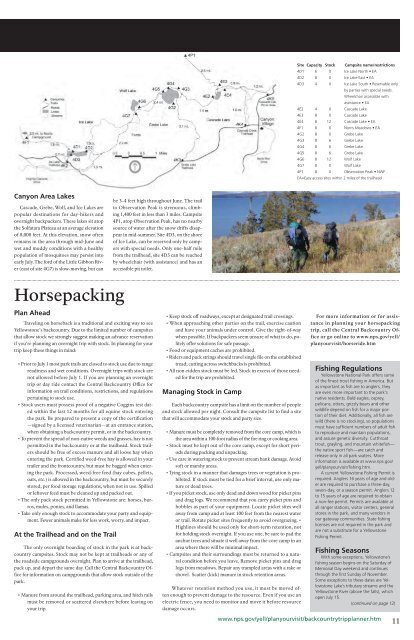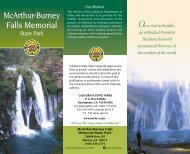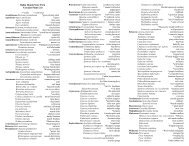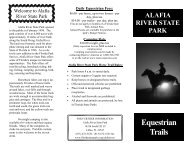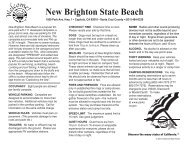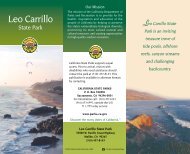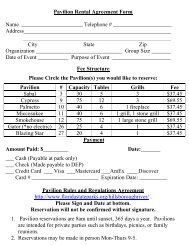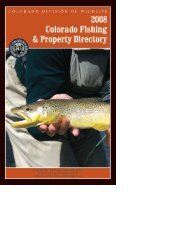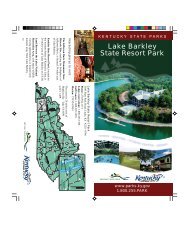Backcountry Trip Planner
Backcountry Trip Planner
Backcountry Trip Planner
- No tags were found...
Create successful ePaper yourself
Turn your PDF publications into a flip-book with our unique Google optimized e-Paper software.
Site Capacity Stock Campsite name/restrictions4D1 6 0 Ice Lake North • EA4D2 8 0 Ice Lake East • EA4D3 4 0 Ice Lake South • Reservable onlyby parties with special needs.Wheelchair accessible withassistance • EA4E2 4 0 Cascade Lake4E3 8 0 Cascade Lake4E4 8 12 Cascade Lake • EA4F1 8 0 Norris Meadows • EA4G2 8 0 Grebe Lake4G3 8 6 Grebe Lake4G4 8 6 Grebe Lake4G5 8 6 Grebe Lake4G6 8 12 Wolf Lake4G7 8 0 Wolf Lake4P1 8 0 Observation Peak • NWFEA=Easy access sites within 2 miles of the trailheadCanyon Area LakesCascade, Grebe, Wolf, and Ice Lakes arepopular destinations for day-hikers andovernight backpackers. These lakes sit atopthe Solfatara Plateau at an average elevationof 8,000 feet. At this elevation, snow oftenremains in the area through mid-June andwet and muddy conditions with a healthypopulation of mosquitoes may persist intoearly July. The ford of the Little Gibbon River(east of site 4G7) is slow-moving, but canbe 3–4 feet high throughout June. The trailto Observation Peak is strenuous, climbing1,400 feet in less than 3 miles. Campsite4P1, atop Observation Peak, has no nearbysource of water after the snow drifts disappearin mid-summer. Site 4D3, on the shoreof Ice Lake, can be reserved only by camperswith special needs. Only one-half milefrom the trailhead, site 4D3 can be reachedby wheelchair (with assistance) and has anaccessible pit toilet........................................................................................................................................................................................................................................................................................................................HorsepackingPlan AheadTraveling on horseback is a traditional and exciting way to seeYellowstone’s backcountry. Due to the limited number of campsitesthat allow stock we strongly suggest making an advance reservationif you’re planning an overnight trip with stock. In planning for yourtrip keep these things in mind:• Prior to July 1 most park trails are closed to stock use due to rangereadiness and wet conditions. Overnight trips with stock arenot allowed before July 1. If you are planning an overnighttrip or day ride contact the Central <strong>Backcountry</strong> Office forinformation on trail conditions, restrictions, and regulationspertaining to stock use.• Stock users must possess proof of a negative Coggins test datedwithin the last 12 months for all equine stock enteringthe park. Be prepared to present a copy of the certification—signed by a licensed veterinarian—at an entrance station,when obtaining a backcountry permit, or in the backcountry.• To prevent the spread of non-native weeds and grasses, hay is notpermitted in the backcountry or at the trailhead. Stock trailersshould be free of excess manure and all loose hay whenentering the park. Certified weed-free hay is allowed in yourtrailer and the frontcountry, but must be bagged when enteringthe park. Processed, weed-free feed (hay cubes, pellets,oats, etc.) is allowed in the backcountry, but must be securelystored, per food storage regulations, when not in use. Spilledor leftover feed must be cleaned up and packed out.• The only pack stock permitted in Yellowstone are: horses, burros,mules, ponies, and llamas.• Take only enough stock to accommodate your party and equipment.Fewer animals make for less work, worry, and impact.At the Trailhead and on the TrailThe only overnight boarding of stock in the park is at backcountrycampsites. Stock may not be kept at trailheads or any ofthe roadside campgrounds overnight. Plan to arrive at the trailhead,pack up, and depart the same day. Call the Central <strong>Backcountry</strong> Officefor information on campgrounds that allow stock outside of thepark.• Manure from around the trailhead, parking area, and hitch railsmust be removed or scattered elsewhere before leaving onyour trip.• Keep stock off roadways, except at designated trail crossings.• When approaching other parties on the trail, exercise cautionand have your animals under control. Give the right-of-waywhen possible. If backpackers seem unsure of what to do, politelyoffer solutions for safe passage.• Food or equipment caches are prohibited.• Riders and pack strings should travel single file on the establishedtread; cutting across switchbacks is prohibited.• All non-ridden stock must be led. Stock in excess of those neededfor the trip are prohibited.Managing Stock in CampEach backcountry campsite has a limit on the number of peopleand stock allowed per night. Consult the campsite list to find a sitethat will accommodate your stock and party size.• Manure must be completely removed from the core camp, which isthe area within a 100-foot radius of the fire ring or cooking area.• Stock must be kept out of the core camp, except for short periodsduring packing and unpacking.• Use care in watering stock to prevent stream bank damage. Avoidsoft or marshy areas.• Tying stock in a manner that damages trees or vegetation is prohibited.If stock must be tied for a brief interval, use only matureor dead trees.• If you picket stock, use only dead and down wood for picket pinsand drag logs. We recommend that you carry picket pins andhobbles as part of your equipment. Locate picket sites wellaway from camp and at least 100 feet from the nearest wateror trail. Rotate picket sites frequently to avoid overgrazing. •Highlines should be used only for short-term retention, notfor holding stock overnight. If you use one, be sure to pad theanchor trees and situate it well away from the core camp in anarea where there will be minimal impact.• Campsites and their surroundings must be returned to a naturalcondition before you leave. Remove picket pins and draglogs from meadows. Repair any trampled areas with a rake orshovel. Scatter (kick) manure in stock retention areas.Whatever retention method you use, it must be moved oftenenough to prevent damage to the resource. Even if you use anelectric fence, you need to monitor and move it before resourcedamage occurs.For more information or for assistancein planning your horsepackingtrip, call the Central <strong>Backcountry</strong> Officeor go online to www.nps.gov/yell/planyourvisit/horseride.htmFishing RegulationsYellowstone National Park offers someof the finest trout fishing in America. Butas important as fish are to anglers, theyare even more important to the park’snative residents. Bald eagles, osprey,pelicans, otters, grizzly bears and otherwildlife depend on fish for a major portionof their diet. Additionally, all fish arewild (there is no stocking), so populationsmust have sufficient numbers of adult fishto reproduce and maintain populations,and assure genetic diversity. Cutthroattrout, grayling, and mountain whitefish—the native sport fish—are catch andrelease only in all park waters. Moreinformation is available at www.nps.gov/yell/planyourvisit/fishing.htm.A current Yellowstone Fishing Permit isrequired. Anglers 16 years of age and olderare required to purchase a three-day,seven-day, or a season permit. Anglers 12to 15 years of age are required to obtaina non-fee permit. Permits are available atall ranger stations, visitor centers, generalstores in the park, and many vendors inour gateway communities. State fishinglicenses are not required in the park andare not a substitute for a YellowstoneFishing Permit.Fishing SeasonsWith some exceptions, Yellowstone’sfishing season begins on the Saturday ofMemorial Day weekend and continuesthrough the first Sunday of November.Some exceptions to these dates are YellowstoneLake’s tributary streams and theYellowstone River (above the falls), whichopen July 15.(continued on page 12)www.nps.gov/yell/planyourvisit/backcountrytripplanner.htm11


